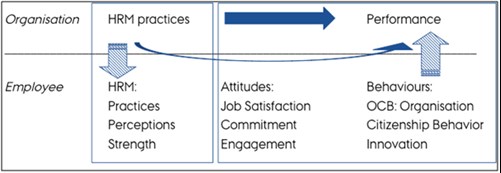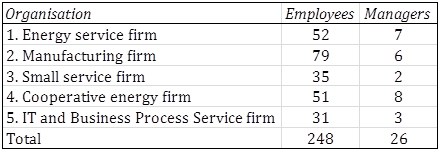Globalt HRM projekt: HRM og medarbejdertrivsel
Aarhus Universitet har gennemført en undersøgelse, der er et led i et større internationalt forskningsprojekt. Forskningsprojektet udføres i samarbejde med forskere fra Aarhus Universitet, Australian School of Business, Universidade Lusíada, University of Twente og Aston University.
Formålet med undersøgelsen er at identificere sammenhængen mellem HRM og medarbejdertrivsel. Det er relevant i forbindelse med at fremme forståelsen af den effekt, som HRM har på en organisations præstation samtidig med, at HRM generelt fremmer tilfredsheden og trivslen blandt medarbejderne.
|
D. 14. august afholdte Aarhus Universitet et seminar, hvor de foreløbige resultater blev præsenteret. Aarhus Universitet har skrevet nedenstående artikel med de foreløbige resultater. Rapporten med de endelige resultater kan hentes her |
Global HRM Project: Preliminary Findings
Af Aarhus Universitet
In this article, we provide an overview of the results from the Global HRM survey as of August 2014. The survey is being conducted in collaboration with researchers from the Australian School of Business, Universidade Lusiada, University of Twente, Aston University, Nottingham-Trent, and Aarhus University.
The overall objective of the survey is to investigate the influence of content and process in HRM, or what is referred in the literature as HRM practices and strength of HRM. In other words, we were interested in how employees perceive the HRM practices that managers report as having been implemented in their organisations.
More specifically, items on the survey aimed to gain an understanding of:
- Which HRM practices are being implemented, according to managers?
- How are these HRM practices perceived by employees?
- Is there alignment between managers and employees?
- What are the effects of implemented/perceived HRM practices on employee attitudes, behaviours, and performance?
- How do results vary in participating countries and organisations?
The general model underpinning the research is shown in Figure 1.

Thus far, data has been collected in 24 organisations in 9 countries (Nigeria, Tanzania, Oman, Malaysia, China, Portugal, UK, Norway (1) and Denmark), with a total of 1649 respondents (1490 employees and 159 managers) (2). By including both employees and managers from the same organisations, the data allow us to compare the HRM practices that have actually been implemented with the employees’ awareness of those practices. Further, we can measure the effect of the implemented HRM practices on employee attitudes, behaviours, and performance, taking into account the degree to which the employees perceive those HRM practices as being present and supportive of their work processes.
In Denmark specifically, survey data were collected in 5 firms (see Table 1). Although results for all countries will be presented in the full report, the primary focus here is to highlight the findings from Denmark as they relate to the international participants.

Generally, our findings show that there are differences between managers’ reporting of HRM practices (i.e. the HRM practices managers’ report of which HRM practices are most salient, i.e. “vigtigst i din organisation”) and employees’ perceptions of these HRM practices. Specifically, we found that Danish employees perceived bonus and incentives and career development as more salient in their organisations than the managers of these Danish organisations. On the other hand, Danish managers perceived training and development, performance appraisal and safety in the workplace as most important HRM practices in their organisation, whereas the employees of these organisations rated these practices as less salient. The importance of communication, recruitment and selection, and union relations where rated similar by managers and employees.
As employee perceptions are highly subjective and experiential measures of HRM practices, these major discrepancies suggest that employees are not experiencing the support and opportunities HRM managers feel the organisations are providing. This finding was consistent for most but not all of the HRM practices. For example, Danish managers indicate the Danish firms to provide sufficient and on-going external training opportunities, whereas employees indicate a less positive perception of the external training opportunities. This type of discrepancy is similar for internal mobility, participation and pay-performance linkages.
In comparison between the countries, this gap between managers’ reports of HRM and employees’ perceptions of HRM was found to be significantly larger in Denmark than many of the other countries included in the project. This finding suggest that Danish employees may be less aware of the HRM practices implemented in their organisations than employees in other countries.
In the full report, results are presented that relate to the effect of HRM practices and processes on employees' attitudes, behaviours, and performance.
Referencer:
(1) As of august 2014, data from Norway has not yet been merged with the data set.
(2) Data collection is still ongoing, and results will be updated as new data becomes available.